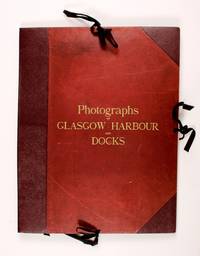
Clyde Navigation. Glasgow Harbour and Docks
by Annan & Sons
- Used
- Condition
- See description
- Seller
-
Norwich, Norfolk, United Kingdom
Payment Methods Accepted
About This Item
The price is £6000 [plus VAT at 20% if applicable]
ANNAN & Sons.
Clyde Navigation. Glasgow Harbour and Docks.
Glasgow, Annan & Sons, 1892-1898
8 platinum prints, 15.5 x 12.0 ins, mounted on original card 25 x 19 ins with printed titles on card, some foxing on images no.5 and 6, preserved in the original portfolio case with ties, rebacked in goatskin, internally lined with archival paper, upper cover lettered gilt Glasgow Harbour and Docks.
Historic archive of photographs in the maritime history of Glasgow – the development of the Clyde Navigation, Harbour and Docks recorded in eight original platinum prints by the famous Glasgow photographers Annan & Sons between 1892 and 1898 and preserved in their original portfolio case.
Glasgow was the second city of the Empire and by the end of the 19th century had become a major Atlantic seaport and the Clyde shipyards were building the most sophisticated and technologically innovative iron and steel ships in the world.
The photographer was John Annan [1862-1947], elder son of Thomas Annan. On Thomas's death in 1887, John and his brother J.Craig Annan divided the responsibilities; J.Craig Annan specialised in portrait photography and John took over the architectural photography.
Not located in any Collection [no.2 in National Gallery of Scotland; no.7 in Glasgow City Archives; no.8 in the Mitchell Library].
See: Nick Robbins, Scotland and the Sea: The Scottish Dimension in Maritime History. 2014
An impressive scene of bustling activity –heavily loaded horse drawn wagons and carts crossing the bridge, people and a horse drawn omnibus with advertising hoarding Van Houten's Cocoa on the side with passengers seated on the upper deck. On the Clyde a small open steam driven cargo boat is moored. and another steam vessel is passing under the bridge. In the background the buildings of the city of Glasgow with advertising hoardings clearly visible – Paisley's Store, Paisley's Clothiers, Wilsons Colosseum, Blind & Sunshade Manufacturers, Nestlé's Milk.
Also known as the Jamaica Street Bridge, built by Thomas Telford in 1836, it was demolished and rebuilt in 1899. [Annan 10164]
Showing arrangement of concrete cylinders and chock piles there, and building on top of cylinders of South Wall of centre basin. In the background five steam cranes and a steam locomotive. [Annan 1039]
Showing in foreground stern of moored steamboat Eliza, Dublin, a steam boat in the river, and in the background many moored steam and masted ships.
Queen's Dock at Stobcross on the north bank offered nearly two miles of quayside from its opening in 1880. The dock was home to the Clan Line for ships bound for South Africa, City Line whose vessels visited the ports along the coast of India and Donaldson Line which specialised in trade with North America.
View of many masted ships in the background behind warehouses, two ships and a small rowing boat in the expanse of the waterway.
Three Graving dry docks were built for the Clyde Navigation Trust between 1869 and 1898, the first dock opening in 1875, the second larger dock in 1886 and the third and largest in 1898. They were extensively used for winter overhauls and refits of Clyde steamers.
View of Glasgow Harbour with a Clutha river steam ferry in the middle of the river loaded with many passengers on the open deck. In the background many masted ships docked at the quayside.
View of two Clutha river steam ferries [ferries going up and down the river Clyde, rather than across, were known as 'Cluthas' and first introduced in 1864 when six were introduced. By 1899 there were twelve plying between Victoria Bridge and Whiteinch Ferry covering three miles and the charge was one penny. By 1903 the Cluthas had ceased with the introduction of electric trams] with many passengers on deck in the foreground, an unidentified paddle steamer moored up at the quay with people boarding and in the background masted ships. On the quayside a bustling scene of wagons, carts, people and children. In the background the hoarding 'Columba and Iona'.
The steam ferries are the Daniel Adamson which is leaving while the paddle steamer S.S..Iona [built 1863 by J & Thomson, of Govan] is still positioning herself ready to reverse into her berth. More details are visible of the quayside where there are bales of hay stacked up and an area reserved for boarding the famed MacBrayne's steamers, Columba and Iona.
Known as the Broomielaw. the Scottish civil engineer, Thomas Telford who redesigned the Broomielaw quays to handle the busy steamboat traffic as thousands of immigrants came over from Ireland in the mid 19th Century to work in the new industries generated by the Industrial Revolution.
View of Prince's Dock looking towards Pacific Quay with numerous masted ships tied up in the background. In the foreground is the massive 1894 steam crane of 130 tons, erected on the West Quay to assist with the fitting of engines and boilers.
Prince's Dock: A large tidal dock, with three basins, lined with two-storey transit sheds. Originally Cessnock Dock, the dock was completed in 1897 when it was renamed Prince's Dock in honour of the Duke of York, The formal opening was performed by the Duchess of York on 10 September 1895. Prince's Dock contained 35 acres of water space, and its bustling quays were generously equipped with two-storey warehouses, cranes, coal hoists and a maze of railway sidings. It cost the Clyde Navigation Trust nearly £1,000,000 to build and equip, excluding the cost of over £280,000 incurred in purchasing the parcels of land which made up the site of nearly 100 acres. With another two miles of wharfes, became home to Anchor Line and Allen Line Ships [Annan 14339]
Reviews
(Log in or Create an Account first!)
Details
- Seller
- Hamish Riley-Smith Rare Books
(GB)
- Seller's Inventory #
- b293
- Title
- Clyde Navigation. Glasgow Harbour and Docks
- Author
- Annan & Sons
- Format/Binding
- Original portfolio case with ties
- Book Condition
- Used
- Quantity Available
- 1
- Publisher
- Annan & Sons
- Place of Publication
- Glasgow
- Date Published
- 1892-1898
- Weight
- 0.00 lbs
- Keywords
- photographs platinum prints
Terms of Sale
Hamish Riley-Smith Rare Books
About the Seller
Hamish Riley-Smith Rare Books
About Hamish Riley-Smith Rare Books
Rare book specialist Hamish Riley-Smith, who died on August 10, did not originally intend to become a dealer.
He went to Trinity College Dublin, where he read economics and met our mother Brigitta (Gita) von Wagner. He planned to work in the family brewing business, John Smith's, and spent seven years learning the craft at Whitbread's. But after all the family interest in John Smith's was sold in 1972, he looked for a new career.
In 1974 he started Hamish Riley-Smith Rare Books. He had no formal training in the book business, other than an acute awareness of business and a degree in economics. He started, in his own words, as a runner, taking one book to another dealer and making a small margin.
Hamish quickly realised this was not for him and started to focus on Arabic and economic books and the social sciences. Through knowledge and research he built up a strong and friendly working relationship with the Japanese, travelling to Japan often. He also traded in Arabia, the US and Europe.
Sacks of catalogues
We can remember how sacks of catalogues would leave the house and go off to museums and institutions across the world, and answers would come back via telex. This was a world before the internet, mobile phones and faxes and computers were only just coming in.
Among his proudest sales were the 14th century Qur'an manuscript of Mameluk Sultan Al Malik Al Nasir Muhammad (pictured here); The Papers of Sir Roy Harrod; The library of Sir John Hicks; The Betjeman Library; typescript/manuscript of Ludwig Wittgenstein's Tractus Logico Philosophicus; The Felibriges Library of Musée Theodore Aubanel, Avignon; as well as collections of Isaac Newton; John Locke; Thomas Hobbes; Shakespeare; William Petty; Robert Owen and Adam Smith.
He was resolute in his independence and had many friends and colleagues in the book business, but he never did a book fair ("I am not a book fairy") and refused to join any trade associations.
He will be remembered by the family as a loving husband, father and grandfather, and a great source of fun and interest; for Hamish, above all, family came first. His business will continue to be run by his wife Gita and two sons, Damian, director of Paragraph Publishing, and Crispian, director of Crispian Riley-Smith Fine Arts Ltd.
Glossary
Some terminology that may be used in this description includes:
- Gilt
- The decorative application of gold or gold coloring to a portion of a book on the spine, edges of the text block, or an inlay in...
- Goatskin
- Goatskin, leather made from goat, is durable and easy to dye. The original and finest examples of Morocco binding are goatskin....
- Rebacked
- having had the material covering the spine replaced. ...
- New
- A new book is a book previously not circulated to a buyer. Although a new book is typically free of any faults or defects, "new"...
This Book’s Categories
Also Recommended
-

Save 10% on every purchase!
Join the Bibliophiles’ Club and start saving 10% on every book.
$29.95 / Year







